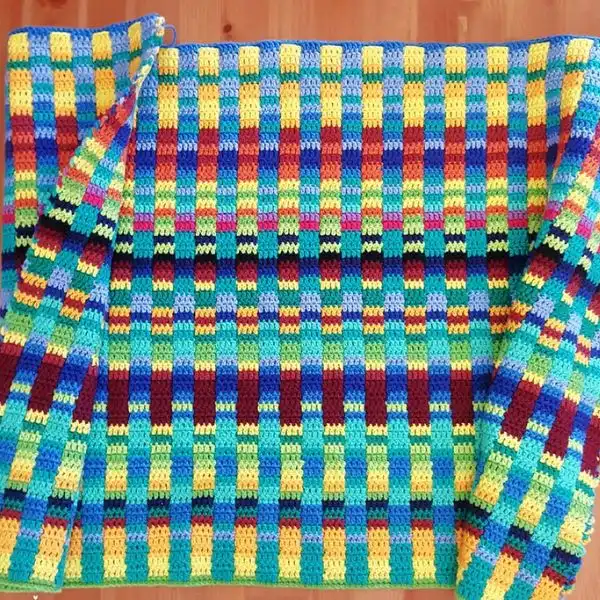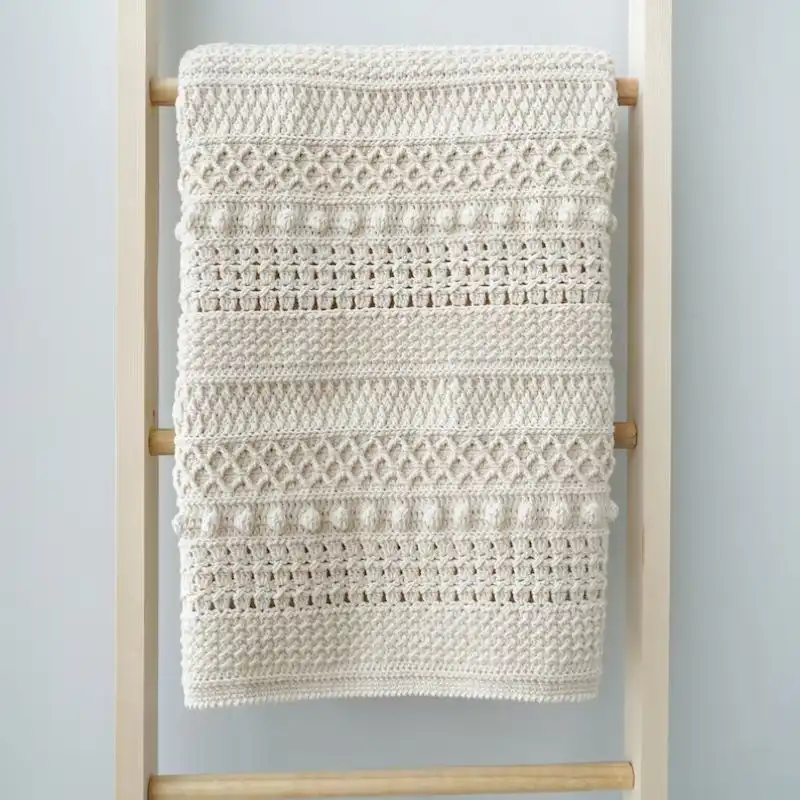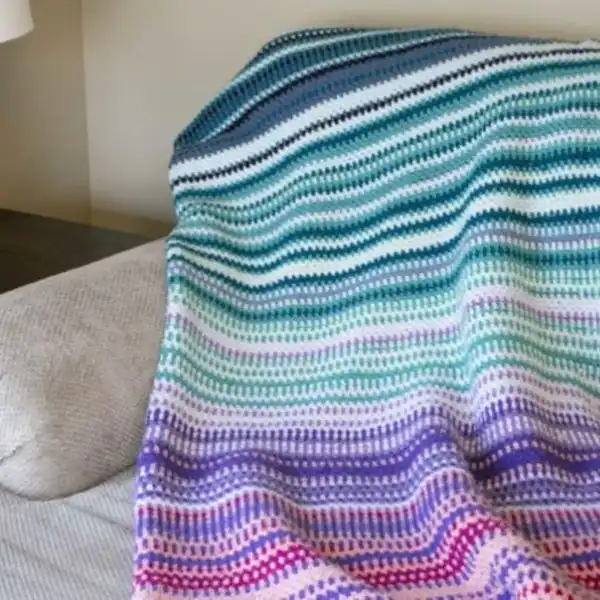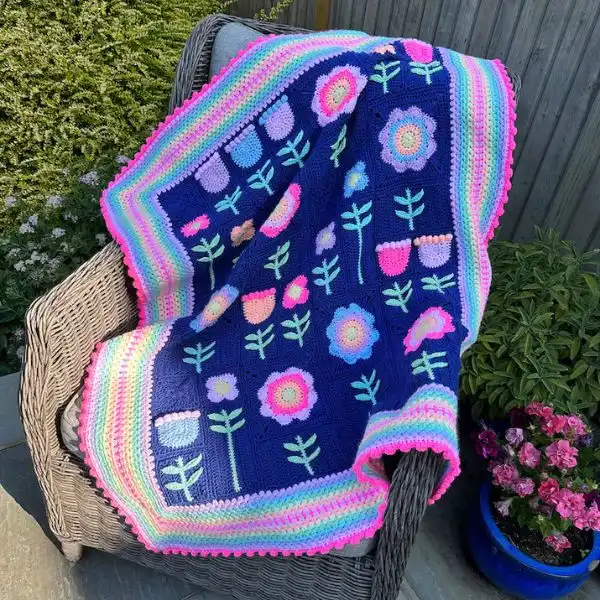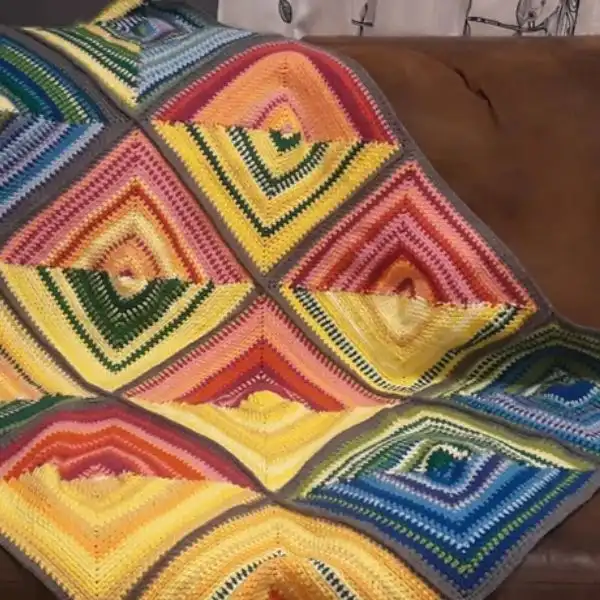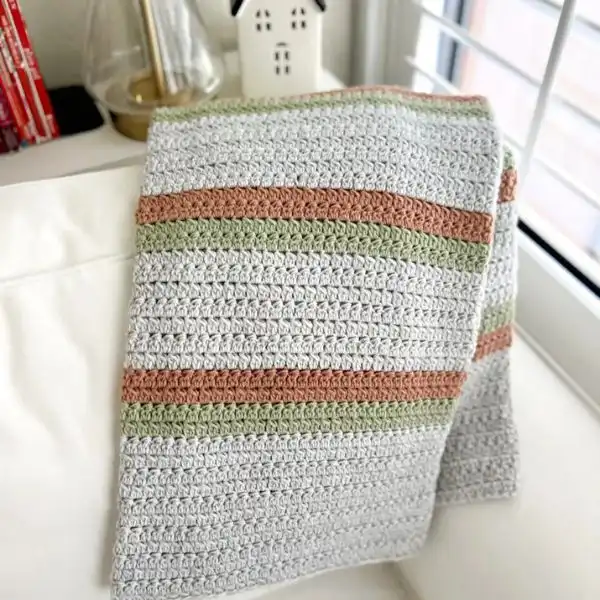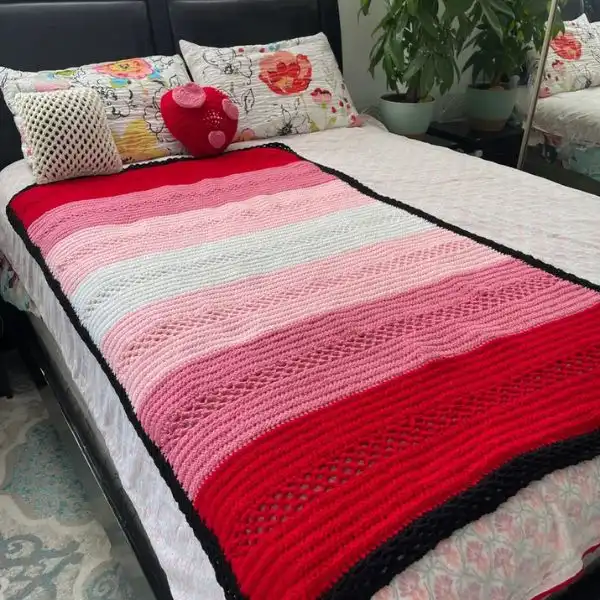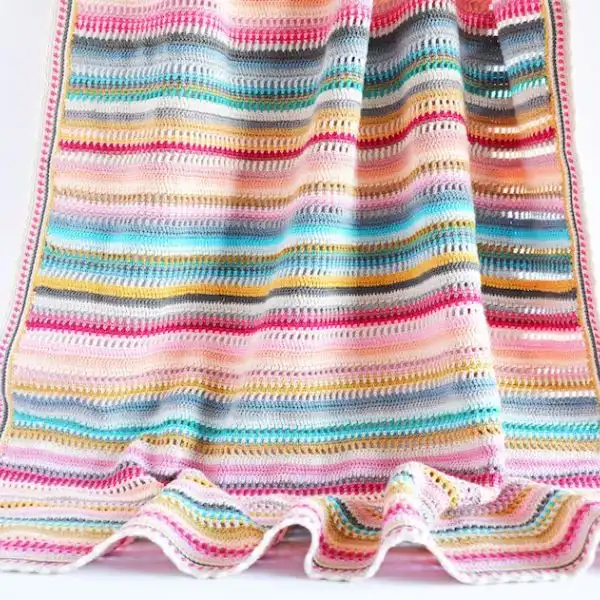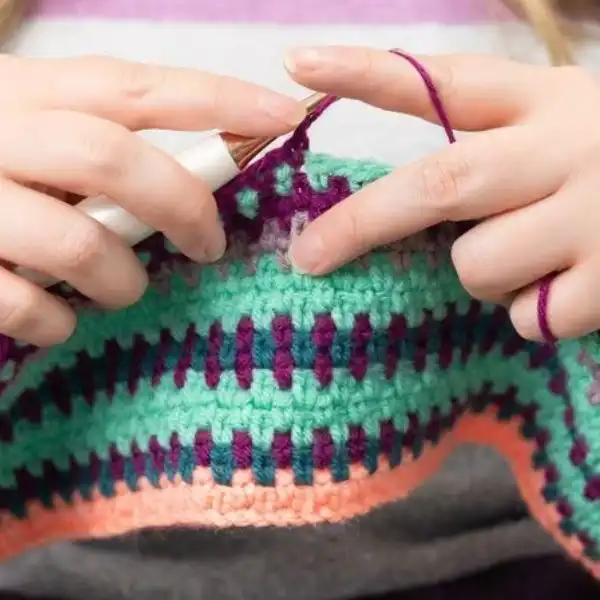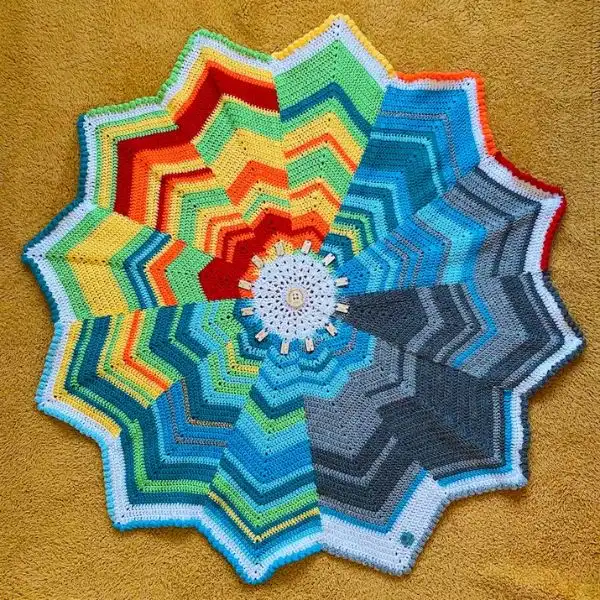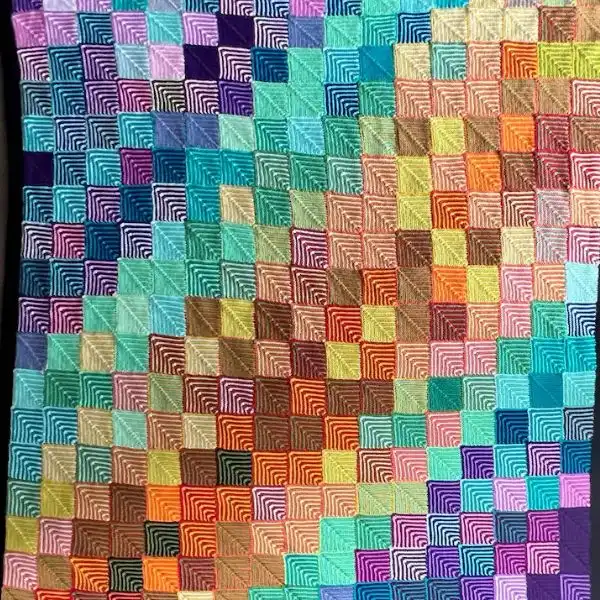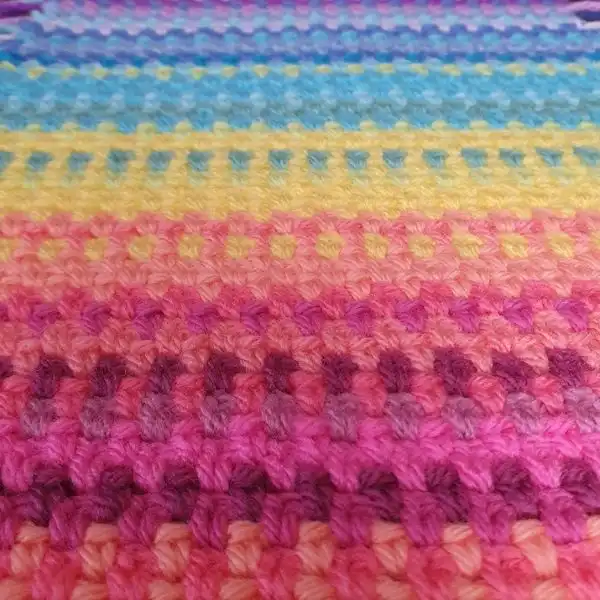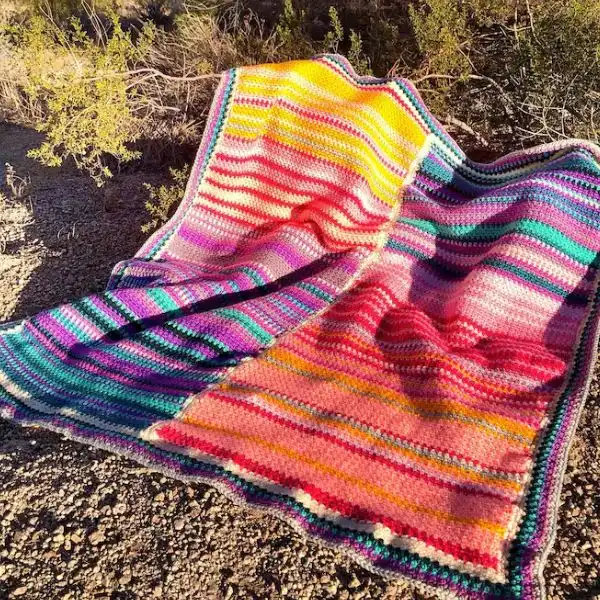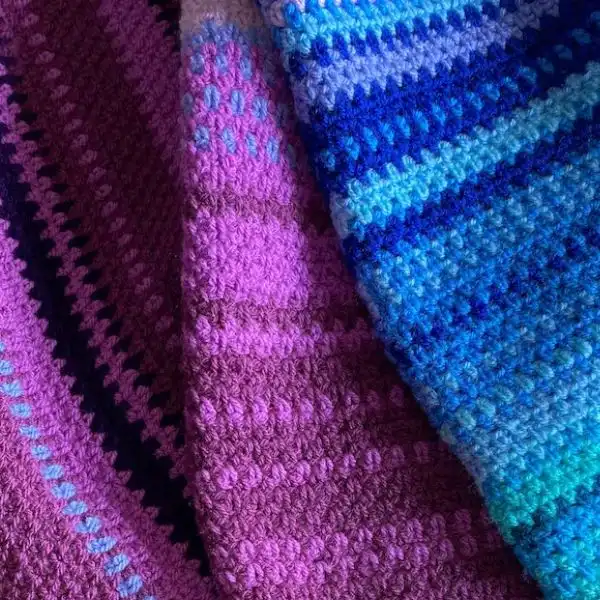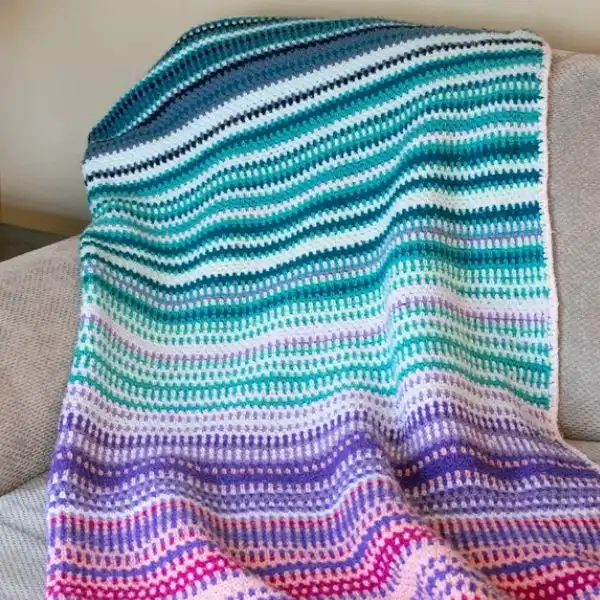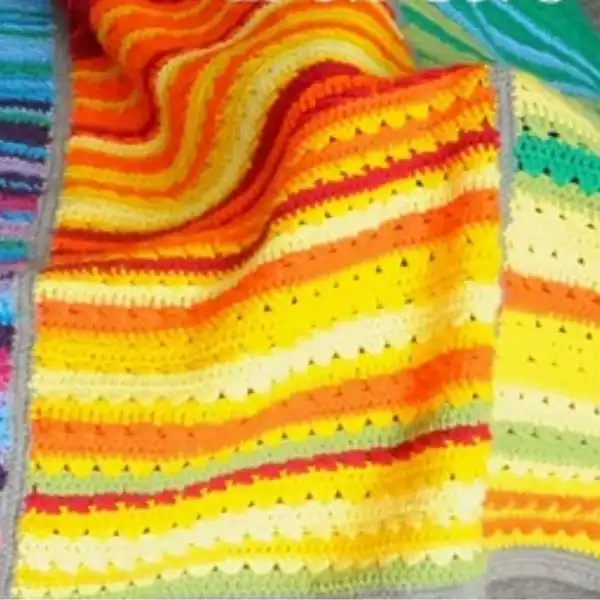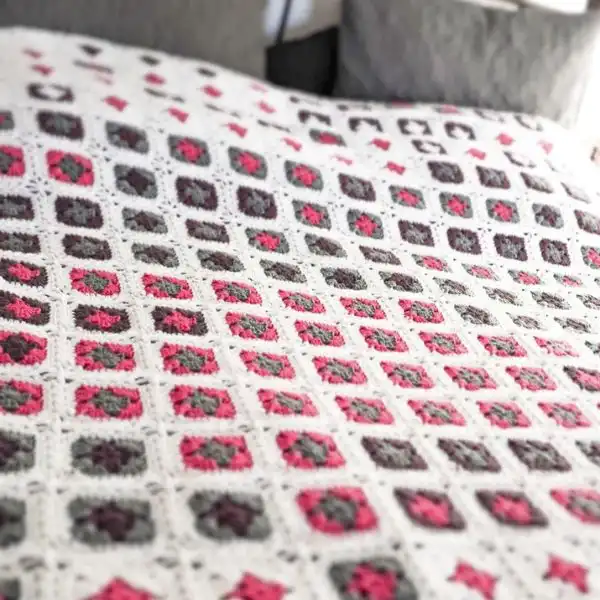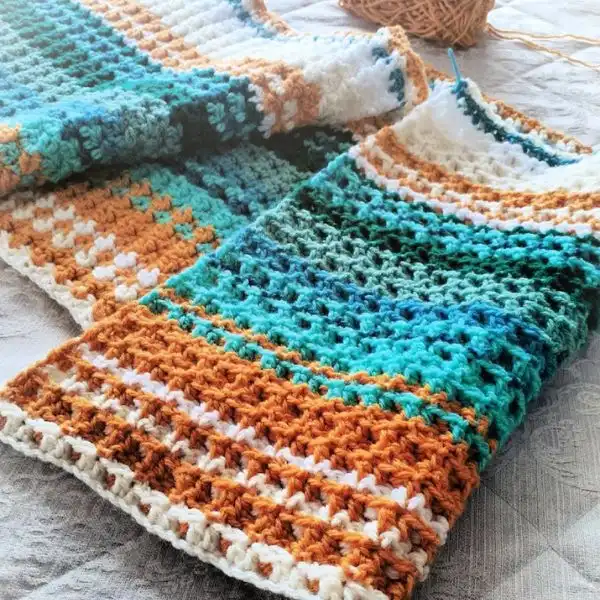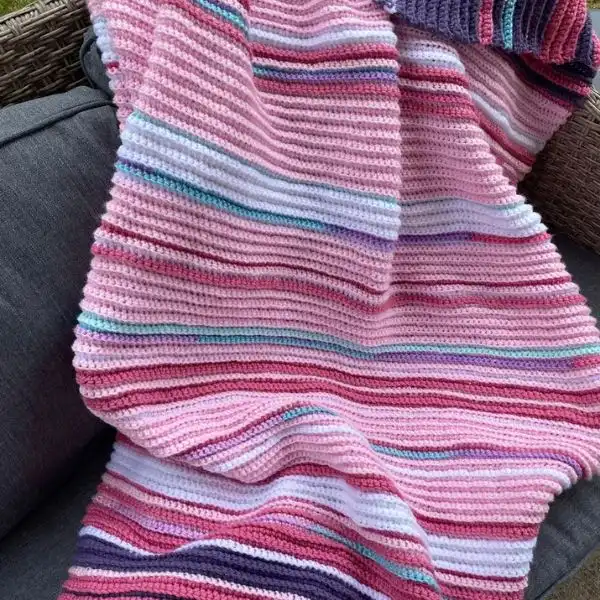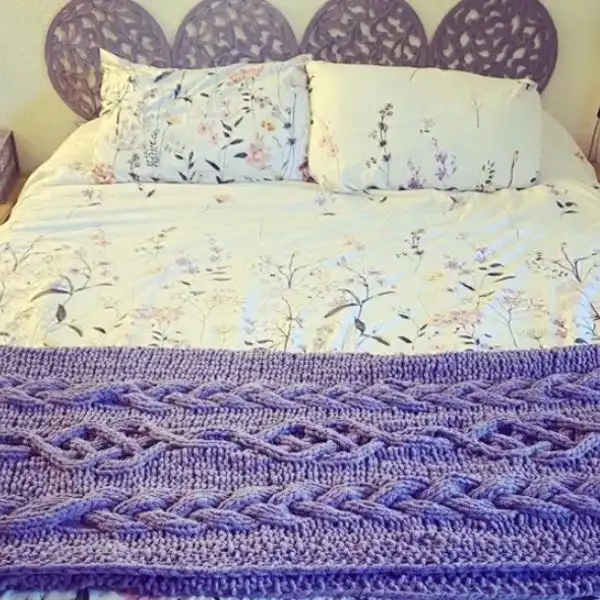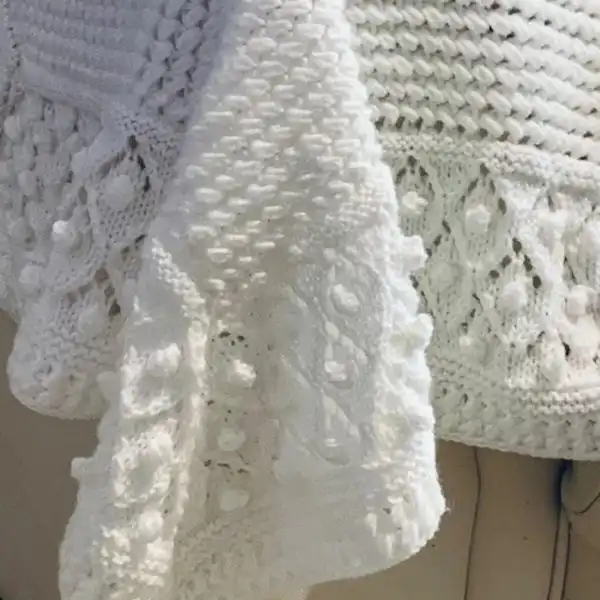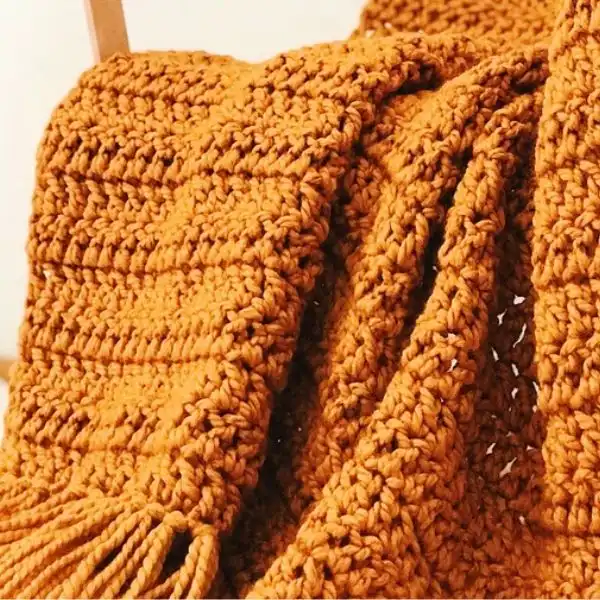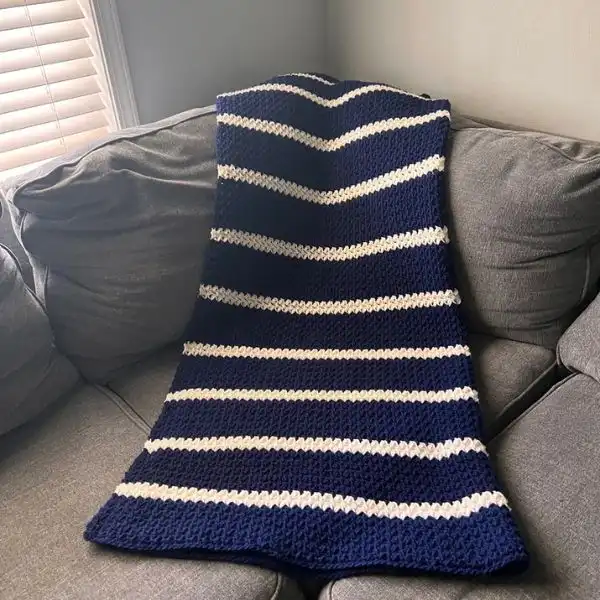Temperature blankets are an incredible way to capture the essence of a year, reflecting the daily highs and lows of the weather beautifully and creatively.

Crochet enthusiasts and beginners alike can embark on the meaningful journey of crafting their very own temperature blanket, where every color represents a unique memory of the year that has passed.
In the crochet world, temperature blankets are considered one of the most personal and nostalgic projects one can undertake.
By following simple steps and guidelines, you, too, can embark on this cherished crafting experience and create a bespoke piece of art that commemorates a particular year in your life.
What Is A Temperature Blanket?
A temperature blanket is a delightful and creative crochet project that captures the essence of daily temperature fluctuations in a particular location over a designated time frame, usually a year.
Each row of the blanket represents a day’s high temperature, which is visually depicted using different yarn colors assigned to specific temperature ranges.
This captivating project not only helps you refine your crocheting skills but also brings the daily weather changes to life in a colorful, unique, and tangible way.
To start your temperature blanket journey, you’ll need to select the color palette you’d like to associate with various temperature ranges.
A widely-used approach is to choose “cool” colors for lower temperatures and “warm” colors for higher temperatures. Consider creating a color-coordinated chart to simplify the process and help maintain consistency throughout the year.
Next, decide on the crochet stitch you want for your temperature blanket. Many stitches are available, so choose one that suits your preferences and skill level. Consider selecting a stitch that will allow the colors to blend smoothly for an eye-catching result.
Benefits Of Crocheting A Temperature Blanket
Crocheting a temperature blanket is not only a fun and engaging project, but it also offers several benefits. This section explores some advantages of diving into this creative endeavor.
- Self-expression and mindfulness: Like any other art form, crocheting allows you to express yourself and your emotions. You create a unique, personal art reflecting your life and environment by choosing colors representing the daily temperatures. Additionally, rhythmic crocheting helps promote mindfulness and relaxation, making it an excellent stress reliever.
- Skill development and learning: Crocheting a temperature blanket is an excellent opportunity to develop and refine new techniques. By working on a large project that spans an entire year, you have ample time to perfect different stitches and become more comfortable with handling various yarn types. You will see your skills grow and improve as your blanket progresses.
- Preserving memories: A temperature blanket is a tangible representation of a specific time in your life. The colors and patterns tell a story of the weather, significant events, and even daily emotions. As you look back on your project, it serves as a keepsake that carries the memories and stories of that particular year.
- Customizable and versatile: There are no strict rules when it comes to crocheting a temperature blanket, and that’s what makes it so appealing. You can choose from various techniques, such as granny squares or Tunisian crochet, to suit your preferences and complete the project independently. Moreover, these blankets can be as intricate or simple as you desire, catering to all skill levels.
How Temperature Blankets Work?
Temperature blankets are a fantastic way to track the passing of time through the lens of weather! Essentially, you visually represent a year’s temperature data through crochet.
The basic idea behind these blankets is to assign a color to a specific temperature range. Then, for each day of the year, you crochet a row with the color that matches the day’s high temperature.
Creating a color-temperature key is essential to make your blanket personal to your location. This key will guide you in assigning colors to specific temperature ranges. You might decide to use 10°F or 5°F intervals, depending on how many colors you want to include in your blanket.
When selecting yarn, most people opt for worsted/aran weight yarns, which are easy to work with and provide a good balance between warmth and weight.
Choose your yarn colors carefully, ensuring they are available in your assigned temperature ranges. Remember that this is a year-long project, so investing in high-quality yarn is worth ensuring your masterpiece stands the test of time.
As you work on your temperature blanket, it’s helpful to maintain a neat and organized workspace. Choose a comfortable spot to sit, relax, and enjoy the creative process. Keep your yarn neatly stored to avoid tangles, and have a calendar or notebook on hand to track your daily temperature data.
Choose The Temperature Range And Colors
Choosing the suitable temperature range and colors for your crochet temperature blanket is crucial in creating a unique and beautiful mantle. Here are a few pointers to help you make your perfect selection.
Firstly, think about the temperature range you’ll be using. It can be based on the average temperatures in your area throughout the year. A great way to do this is by checking your local weather data.
You can choose smaller increments like 5°F or larger intervals like 10°F, depending on how many colors you want to include in your blanket.
Once you’ve selected your temperature range, it’s time to pick your colors. You can get creative and choose a color palette that speaks to you. Some popular options include using pastels, neons, or even the colors of a favorite garment or cherished heirloom.
For inspiration, you can explore color palettes on sites like Pinterest or look up completed temperature blanket projects on Ravelry.
Now, assign each color to a specific temperature range. You can create color charts to keep track of the colors and their corresponding temperatures. Here is an example of creating a temperature-color key for 10-degree intervals:
Temperature Range Color
30-39°F Blue
40-49°F Green
50-59°F Yellow
60-69°F Orange
70-79°F Red

Different Crochet Stitches For Temperature Blankets
Temperature blankets are a fantastic way to document the year’s weather in a beautiful and unique keepsake. When creating your temperature blanket, selecting the right crochet stitch to showcase the colors and temperature changes throughout the year is essential.
Here are a few crochet stitches that are ideal for temperature blankets:
- Moss Stitch: This lovely stitch is perfect for temperature blankets because of its texture and modern appearance. It’s created by alternating single crochet and chain stitches, creating a dense fabric that’s still lightweight and flexible. You can use the Moss Stitch in a Square for an exciting variation.
- Seed Stitch: With its delightful texture and simple pattern, the seed stitch is another excellent choice for temperature blankets. This stitch combines single and double crochet stitches, making it versatile enough to work with various yarn weights.
- Double Moss Stitch: Similar to the moss stitch, the double moss stitch offers an attractive textured fabric suitable for a temperature blanket. This stitch is created by alternating two rows of knit stitches with two rows of purl stitches in a checkerboard pattern.
When choosing a stitch for your temperature blanket, consider the following factors:
- Ease of use: Select a stitch you’re comfortable working with, as you’ll be crocheting a row daily for an entire year.
- Visual appeal: The stitch should showcase the different colors representing temperature ranges and create an eye-catching pattern that reflects the year’s temperature fluctuations.
Essential Tools & Materials
As you embark on your crochet temperature blanket journey, gather these essential tools and materials to ensure a smooth and enjoyable experience.
Abbreviations Of Common Crochet Stitches And Techniques
Once upon a time, you embarked on the delightful journey of crafting a temperature blanket. To aid you in your adventure, this whimsical glossary guides you through the magical realm of crochet stitches and techniques. For you are about to become a skillful crochet wizard.
- The single crochet (sc) is the most basic and standard stitch in the land of crochet. To create this stitch, insert your hook into a chain, yarn over and pull through, yarn over once more, and pull through both loops on your hook. You have mastered the single crochet.
- Venturing deeper into your quest, you’ll encounter the half-double crochet (hdc). Slightly taller than the single crochet, it adds an extra step. Yarn over, insert your hook into the chain, yarn over again, and pull through the chain, and finally, yarn over and pull through all three loops on your hook. You have conquered the half-double crochet.
- Now, prepare to wield the double crochet (dc) power. This stitch creates a taller, more open fabric. Yarn over, insert your hook into the chain, thread over and pull through the chain, cord over and pull (tug) through two loops, then yarn over (above) again and pull (tug) through the last two loops. You are now a maestro of the double crochet.
- Behold the treble crochet (tr), the tallest common stitches. Yarn over twice, insert your hook into the chain, thread over and pull through the chain, cord over and pull (tug) through two loops, yarn over and pull through two more circles, and finally, yarn over and pull through the remaining two loops. The treble crochet is now within your grasp.
Which Yarn Is Best For A Crochet Temperature Blanket?
When choosing the perfect yarn for your crochet temperature blanket, there are various factors to consider, so let’s dive right in. The first thing you want to feel is the yarn’s weight.
More often than not, people opt for DK weight yarn for their temperature blankets, as it provides both durability and a comfortable texture.
Next, consider the material or blend of fibers for your yarn. While acrylic yarn might be the most popular choice due to its affordability, easy care, and versatility, you could explore other options like cotton, wool, or a blend of different fibers.
Remember your climate, the intended use of the blanket, and your preferences when deciding on the yarn material.
Here are some key characteristics to look for when selecting the best yarn for your crochet temperature blanket:
- Soft and comfortable against the skin
- Durable and able to withstand daily use
- Easy to care for, ideally machine washable and dryable
- Available in a wide range of colors to represent the temperature changes
Speaking of colors, choosing the right color palette is an essential part of creating your unique temperature blanket. There are numerous ways to decide on the perfect color palette:
- Search Pinterest for “color palettes.”
- Browse temperature blanket projects on Ravelry
- Choose colors from a favorite garment or a cherished heirloom
- Use the colors of your favorite sports team as inspiration
How Much Yarn Do I Need For Temperature Blankets?
In the enchanting world of temperature blankets, the amount of yarn you need depends on the size of your blanket, the weight of your chosen yarn, and the temperatures in your area. Fear not, for here’s a general idea to get you started on your mystical journey.
Typically, knitted temperature blankets require between 1300-2000 yards of yarn, while crocheted blankets use around 1800-3000 yards. To ensure you have enough yarn, consider these factors:
- Yarn weight: The type of yarn you select affects the size of your blanket. Remember that using worsted weight or bulky 6 yarn will alter the finished blanket dimensions.
- Hook size: Your crochet hook size varies based on the weight of your yarn. Remember to consult your yarn’s label for the recommended hook size.
As you weave your tale of temperature artistry, the colors, and yarn you choose play a significant role. Consider exploring yarn recommendations such as Brava Worsted, Swish DK, and Palette to make your blanket magical.
Is It Beginner-Friendly?
Crocheting a temperature blanket is not only an exciting project but also beginner-friendly. It allows you to explore your creativity and practice various crochet techniques throughout the year while making a unique keepsake.
As a beginner, you’ll appreciate the simplicity and versatility of temperature blanket patterns. You can choose a basic stitch like the single crochet stitch, which is easy to learn and gives your blanket a uniform appearance. As you progress, you can experiment with different stitches and patterns.
While working on your temperature blanket, you’ll gain confidence in your crochet abilities as the task becomes more familiar with each day’s progress. To make your blanket-making experience even more enjoyable, follow these tips:
- Plan your project: Before you begin, decide on the size, stitch, yarn type, and color scheme. Ensure you have enough yarn to avoid running out of colors midway through the project.
- Keep a temperature record: Track the daily temperature where you’ll make your blanket and assign a color to each range. It will help to maintain consistency throughout the project.
- Be patient: While it may seem challenging initially, don’t get discouraged. Practice makes perfect, and soon you’ll look forward to each day’s addition to your beautiful temperature blanket.
How To Crochet Your Temperature Blanket?
Are you ready to embark on a whimsical crochet journey? Let me guide you in creating your very own temperature blanket with the perfect stitch and gauge. Grab your crochet hook, and let’s get started!
- First, decide on a temperature range based on your area’s climate. You can opt for either 10-degree increments (50-59 degrees, 60-69 degrees, etc.) or 5-degree increments (50-54 degrees, 55-59 degrees, etc.). Choosing a consistent range will set the foundation for your blanket’s color scheme.
- Next, select a color palette to represent each temperature range. Assign different shades or hues to various temperature ranges. For example, more excellent colors like blues and greens for lower temperatures and warmer colors like reds and oranges for higher temperatures. It will create a stunning visual representation of the year’s temperatures.
- To maintain the desired dimensions and ensure an even project, it’s crucial to determine your stitch count and gauge beforehand. A simple and popular stitch for temperature blankets is the single crochet stitch. You can also choose Tunisian crochet, as shown in this free pattern.
- Create a small swatch using your chosen stitch to measure your gauge — the number of stitches per inch, both horizontally and vertically. It will help you calculate the total number of stitches needed for the width and length of your blanket.
- Now you’re all set to start crocheting your temperature blanket! Begin by chaining the required number of stitches for your desired width, and start crocheting one row or set of squares for each day, using your assigned color for that day’s temperature.
35 Different Temperature Blankets
1. Lines And Stripes Blanket
A classic and versatile design featuring lines and stripes in various colors, representing temperature fluctuations throughout the year. This blanket will add a touch of elegance and warmth to any room.
Suggested Yarn: Acrylic Worsted
Difficulty Level: Intermediate
Yarn Weight: Worsted
Crochet Hook: G (4.0 mm)
2. Crochet Throw Blanket
Wrap yourself up in the comforting embrace of this fireside-inspired crochet throw blanket. The color palette is reminiscent of a crackling hearth, making it perfect for those chilly winter nights.
Suggested Yarn: Acrylic Worsted
Difficulty Level: Beginner
Yarn Weight: Worsted
Crochet Hook: H (5.0 mm)
3. Cozy Fireside
Wrap yourself in the warmth and comfort of the Cozy Fireside Crochet Throw Blanket. This delightful crochet project is inspired by the inviting ambiance of a crackling fireplace, making it the perfect companion for chilly winter nights or whenever you desire a snug and cozy blanket.
Suggested Yarn: Acrylic Bulky
Difficulty Level: Intermediate
Yarn Weight: Bulky
Crochet Hook: N (10.0 mm)
RELATED: Easy Crochet Bookmark: Perfect Project for Beginners
4. Spring Meadow
Bring the essence of spring into your home with the Spring Meadow blanket. Soft pastel shades and floral motifs will capture the beauty of nature’s rebirth.
Suggested Yarn: Cotton Worsted
Difficulty Level: Beginner
Yarn Weight: Worsted
Crochet Hook: H (5.0 mm)
5. Split Square Blanket
Embrace the coolness of the Arctic with this icy-themed temperature blanket. Cool blues and whites will create a serene and calming atmosphere.
Suggested Yarn: Acrylic Bulky
Difficulty Level: Intermediate
Yarn Weight: Bulky
Crochet Hook: N (10.0 mm)
6. Tropical Paradise
Escape to a tropical paradise with this vibrant and lively temperature blanket. Lush greens, sunny yellows, and ocean blues will transport you to an island getaway.
7. Autumn Harvest
Celebrate the fall season with the warm hues of the Autumn Harvest blanket. Rich oranges, browns, and deep reds will evoke the beauty of falling leaves.
Suggested Yarn: Acrylic Worsted
Difficulty Level: Intermediate
Yarn Weight: Worsted
Crochet Hook: 5.5mm (I/9)
8. Heirloom Blanket Crochet Pattern
Craft a timeless piece you will treasure for generations. This sophisticated pattern combines intricate stitches and a varied color scheme to create a true heirloom.
Suggested Yarn: Acrylic Worsted
Difficulty Level: Intermediate
Yarn Weight: Worsted
Crochet Hook: H (5.0 mm)
9. Iheartu Crochet Beginner Blanket
Ideal for beginners, this heart-themed temperature blanket will fill your heart with pride and joy as you see your crochet skills grow.
Suggested Yarn: Acrylic Worsted
Difficulty Level: Beginner
Yarn Weight: Worsted
Crochet Hook: H (5.0 mm)
10. Snowy Peaks
Capture the majesty of snow-capped mountains with the Snowy Peaks blanket. Cool grays and whites will make you feel snug and cozy during winter.
Suggested Yarn: Acrylic Worsted
Difficulty Level: Intermediate
Yarn Weight: Worsted
Crochet Hook: G (4.0 mm)
11. Stripes & Colors
Get creative with this fun and customizable temperature blanket. Experiment with different stripe patterns and color combinations to express your unique style.
12. Make Your Own Temperature Blanket
This pattern provides a template for creating a personalized temperature blanket. Please select your favorite stitches and colors to make it uniquely yours.
Suggested Yarn: Acrylic Worsted
Difficulty Level: Advanced
Yarn Weight: Worsted
Crochet Hook: G (4.0 mm)
13. Star Temperature Blanket
Stargaze under the warmth of this celestial-themed temperature blanket. Twinkling stars and deep midnight blues create a captivating visual.
Suggested Yarn: Acrylic Worsted
Difficulty Level: Intermediate
Yarn Weight: Worsted
Crochet Hook: H (5.0 mm)
14. High-Low Temperature Blanket
Explore the extremes of temperature with this unique high-low design. Watch as your blanket showcases the hottest and coldest days of the year.
Suggested Yarn: Acrylic Worsted
Difficulty Level: Intermediate
Yarn Weight: Worsted
Crochet Hook: G (4.0 mm)
15. Ultimate Temperature Blanket
A comprehensive and ambitious temperature blanket that covers an entire year. This project will be a labor of love, resulting in a remarkable keepsake.
Suggested Yarn: Acrylic Worsted
Difficulty Level: Advanced
Yarn Weight: Worsted
Crochet Hook: G (4.0 mm)
16. Moss Stitch Blanket
Experience the soothing texture of the moss stitch in this temperature blanket. Its simplicity and elegance will make it a favorite for all seasons.
Suggested Yarn: Acrylic Worsted
Difficulty Level: Beginner
Yarn Weight: Worsted
Crochet Hook: H (5.0 mm)
17. Baby Sea Turtle Blanket
Adorned with adorable sea turtle motifs, this temperature blanket is perfect for little ones. Soft pastels and cute designs make it an ideal baby shower gift.
Suggested Yarn: Cotton Worsted
Difficulty Level: Intermediate
Yarn Weight: Worsted
Crochet Hook: H (5.0 mm)
18. My Temperature Blanket
A truly personal and reflective blanket that allows you to express emotions through colors and patterns, making it a therapeutic and meaningful project.
Suggested Yarn: Acrylic Worsted
Difficulty Level: Intermediate
Yarn Weight: Worsted
Crochet Hook: H (5.0 mm)
RELATED: Fun Amigurumi Turtle Patterns That You Can Download And Make Right Now!
19. Granny Stripe Blanket
A timeless classic, the Granny Stripe blanket is an easy-to-follow pattern that creates a cozy and comforting throw.
Suggested Yarn: Acrylic Worsted
Difficulty Level: Intermediate
Yarn Weight: Worsted
Crochet Hook: G (4.0 mm)
20. Mini French Square Blanket
An exquisite and intricate pattern that combines French squares into a compact and elegant temperature blanket.
Suggested Yarn: Acrylic Worsted
Difficulty Level: Intermediate
Yarn Weight: Worsted
Crochet Hook: G (4.0 mm)
21. C2C Squares Blanket
Explore the captivating world of corner-to-corner crochet with this stunning squares blanket. The geometric design allows you to showcase a variety of colors representing temperature fluctuations.
Suggested Yarn: Acrylic Worsted
Difficulty Level: Intermediate
Yarn Weight: Worsted
Crochet Hook: H (5.0 mm)
22. Beautiful Temperature Blanket
Experience the joy of creating a beautiful temperature blanket that reflects the changing seasons in all their splendor. This pattern emphasizes elegance and creativity.
Suggested Yarn: Acrylic Worsted
Difficulty Level: Advanced
Yarn Weight: Worsted
Crochet Hook: G (4.0 mm)
23. DIY Temperature Afghan
Unleash your creativity with this Do-It-Yourself Afghan pattern. Personalize your color choices and stitch combinations to make this blanket uniquely yours.
Suggested Yarn: Acrylic Worsted
Difficulty Level: Intermediate
Yarn Weight: Worsted
Crochet Hook: H (5.0 mm)
24. Seed Stitch Blanket
Embrace the timeless charm of the seed stitch with this temperature blanket. Its delicate texture and subtle color changes create a soothing and comforting effect.
Suggested Yarn: Acrylic Worsted
Difficulty Level: Beginner
Yarn Weight: Worsted
Crochet Hook: H (5.0 mm)
25. Gradient Blanket
Take a journey through a mesmerizing gradient of colors with this temperature blanket. From cool to warm tones, this blanket will be a visual delight.
Suggested Yarn: Acrylic Worsted
Difficulty Level: Beginner
Yarn Weight: Worsted
Crochet Hook: G (4.0 mm)
26. Adding Up Memories Blanket
Create a keepsake of memories with this temperature blanket. Each stitch represents a particular day, making it a cherished memento of the year.
Suggested Yarn: Acrylic Worsted
Difficulty Level: Advanced
Yarn Weight: Worsted
Crochet Hook: G (4.0 mm)
27. Zinnia Hexagon Blanket
Dive into the world of hexagons with this enchanting temperature blanket. Inspired by zinnia flowers, this blanket exudes vibrancy and charm.
28. Degrees Of Separation Blanket
Explore the degrees of temperature separation with this unique and eye-catching pattern. Color transitions showcase the differences in temperatures throughout the year.
Suggested Yarn: Acrylic Worsted
Difficulty Level: Intermediate
Yarn Weight: Worsted
Crochet Hook: H (5.0 mm)
29. Senior Year Blanket
Commemorate a significant milestone with the Senior Year blanket. Perfect for a graduating senior, this blanket captures memories and the excitement of the future.
Suggested Yarn: Acrylic Worsted
Difficulty Level: Advanced
Yarn Weight: Worsted
Crochet Hook: G (4.0 mm)
30. Jacquard Temperature Blanket
Master the art of jacquard crochet with this intricate temperature blanket. Rich patterns and colorwork make it a show-stopping centerpiece.
Suggested Yarn: Acrylic Worsted
Difficulty Level: Advanced
Yarn Weight: Worsted
Crochet Hook: G (4.0 mm)
31. Fire And Ice
Witness the contrast between the fire’s warmth and the ice’s coolness in this temperature blanket. Fiery reds and icy blues create a captivating visual spectacle.
Suggested Yarn: Acrylic Worsted
Difficulty Level: Intermediate
Yarn Weight: Worsted
Crochet Hook: G (4.0 mm)
32. Soft Snowfall
Experience the peacefulness of a soft snowfall with this cozy and gentle temperature blanket. Delicate whites and soft grays evoke the tranquility of winter.
Suggested Yarn: Acrylic Worsted
Difficulty Level: Beginner
Yarn Weight: Worsted
Crochet Hook: H (5.0 mm)
33. Golden Hour
Bask in the warm glow of the Golden Hour blanket. Rich golden hues represent the magical time when the sun sets or rises.
Suggested Yarn: Acrylic Worsted
Difficulty Level: Intermediate
Yarn Weight: Worsted
Crochet Hook: G (4.0 mm)
RELATED: 25 Amazing Diamond Stitch Crochet Blanket Patterns (With Pictures)
34. Thick And Cozy Throw Blanket
Embrace the warmth and comfort of this thick and cozy temperature blanket. Its plush texture will keep you snug during colder months.
Suggested Yarn: Acrylic Worsted
Difficulty Level: Advanced
Yarn Weight: Worsted
Crochet Hook: G (4.0 mm)
35. Quilted Temperature Blanket
Blend the art of quilting with crochet in this temperature blanket. Quilt-like squares and varying colors add a touch of vintage charm.
Suggested Yarn: Acrylic Worsted
Difficulty Level: Advanced
Yarn Weight: Worsted
Crochet Hook: G (4.0 mm)
Tips For A Perfect Temperature Blanket
Crocheting a temperature blanket can be both fun and meaningful. Here are some tips to help you create the perfect masterpiece that reflects the temperature changes throughout the year.
- First, choose a suitable temperature range. You can opt for 10-degree increments (e.g., 50-59 degrees, 60-69 degrees) or 5-degree increments (e.g., 50-54 degrees, 55-59 degrees). The choice depends on your local climate and personal preference.
- Next, decide on a color palette. Pick colors that correspond to the temperature ranges for your area. You can go for soft shades like pinks, oranges, yellows, greens, blues, and purples, desaturated colors for a more formal look, or neutral colors like white, beige, and gray. The key is creating a visually appealing blanket that accurately reflects the temperature changes.
- Now, plan your daily stitch pattern and blanket size. Some people prefer a simple single crochet stitch for each day, while others may opt for more elaborate stitches. Estimate the final size of your blanket based on the stitch pattern and number of days you are tracking.
- Keep a temperature chart handy. As you work on your blanket throughout the year, it’s essential to maintain a temperature chart that records the daily temperature and its corresponding color. This chart helps keep your project organized and prevents any confusion later.
- Finally, embrace the project’s unique nature. A temperature blanket is a beautiful reflection of the year’s weather and your creativity. So, trust your instincts, and don’t be afraid to adjust the design or colors as needed.
Is Blocking Necessary For Temperature Blocking?
As you embark on your journey to create the perfect temperature blanket, you might wonder if blocking is necessary for your masterpiece.
Blocking, gently stretching, and manipulating your crochet work can enhance your creation’s shape and size. While not always mandatory, implementing blocking techniques can benefit your temperature blanket project.
First, consider the benefits that blocking can provide for your crochet work. By settling your stitches into place, blocking allows your yarn to breathe, relax, and settle after all the twisting and pulling. It makes for smoother and more even fabric, enhancing the overall appearance of your blanket.
Additionally, the type of yarn you use for your temperature blanket plays a significant role in whether or not blocking is necessary. Blocking techniques may vary based on the yarn type, as some materials respond better to specific methods. For example, when blocked, wool and cotton yarns often yield the best results.
Suggestions For Adding Personal Touch
When crocheting your perfect temperature blanket, there are a few ways to add a personal touch and make it even more special. Here we have some suggestions to make your temperature blanket truly one of a kind.
First, finding your unique color palette is critical. You can choose colors representing the temperature ranges to reflect your taste and style. If you love pastels, go for it! If you’re into bold colors, that works too! Feel free to play around with different shades and hues to create a palette that’s truly your own.
Next, think about incorporating fun stitches into your blanket design. You can use various crochet stitches for each temperature range instead of just one stitch for the entire blanket.
For example, you may use the granny stitch for cooler days and the moss stitch for warmer days. By doing this, you’ll not only have a visually appealing blanket, but it will also showcase your crochet skills.
In addition to stitches, consider adding textured elements such as bobbles or cables to represent specific events or milestones throughout the year. These unique elements mark special occasions like birthdays, anniversaries, or holidays. It’s an excellent way to make your temperature blanket a meaningful memento of your year.
Lastly, customized borders and edgings can elevate your temperature blanket‘s design. Experiment with different border patterns or edging techniques that complement your chosen color scheme and stitch patterns. This thoughtful touch adds more personality to your blanket and brings your creation together.
Guidance On How To Care For The Blanket
Caring for your crochet temperature blanket is vital to extend its life and maintain its beauty. Here are some tips and advice to make sure your blanket stays pristine.
- Handwashing is best
- Always opt for handwashing for delicate or intricate crocheted blankets.
- Gently soak your blanket in a tub or washing basin filled with lukewarm water and a small amount of mild detergent.
- Avoid hot water to prevent shrinkage.
- Swirl the blanket around in the water, but do not wring or twist it.
- Machine washing considerations: If you prefer a washing machine, choose a front-load washer without a center agitator, as this lessens the chances of stretching your blanket. Select a gentle cycle using cold water and mild detergent.
- Drying techniques: Air drying is the safest method for your crochet temperature blanket. Lay it flat on a clean, dry towel, and gently smooth out any wrinkles. Please keep it away from direct sunlight to avoid color fading.
- Storage tips: When not using your crochet temperature blanket, store it in a cool, dry, and well-ventilated place. Fold it carefully to avoid putting undue stress on the stitches. Placing a breathable cloth over it will help prevent dust accumulation.
A Quick Recap
In this whimsical journey of crafting your perfect temperature blanket, let’s briefly revisit the key steps to confidently create your unique masterpiece with a keen sense of knowledge.
Firstly, choose your temperature range. This essential step relies on the average temperature range of your area. It assigns different colors to various temperature ranges—an astounding tapestry of colors that accurately reflect your year’s temperature fluctuations.
Select a crochet pattern to use for your blanket. Plenty of freeways are available, like this Tunisian Crochet Temperature Blanket Free Pattern. This pattern features helpful tutorial videos and expert advice to help you craft your perfect temperature blanket smoothly.
Remember the importance of choosing the right yarn weight for your project! The weight of the yarn will determine the overall feel, drape, and warmth of your blanket. Consider using a DK weight yarn (#3) for a lightweight yet cozy result.
Finally, mark your progress with a temperature tracker. This handy tool will help you record your area’s daily high or low temperature over the year. A well-organized tracker will ensure your temperature blanket accurately follows the patterns and temperatures of the year with ease.
Frequently Asked Questions
How Do I Choose A Color Chart For My Temperature Blanket?
Choosing a color chart for your temperature blanket can be fun and creative! Decide your preferred temperature ranges and assign a corresponding yarn color to each field. You can make it more personalized by selecting colors that have a special meaning to you or follow a specific theme. Experiment with various shades and combinations to create a visually appealing palette.
What Are Some Popular Crochet Stitches For Creating A Temperature Blanket?
There’s a wide array of crochet stitches to choose from when making a temperature blanket. Some popular stitches include the single crochet stitch, double crochet stitch, half double crochet stitch, and the Tunisian stitch. Take the time to explore different stitches and find the one that best suits your skill level and style preference.
How Can I Create A Temperature Blanket Using Granny Squares?
Creating a temperature blanket with granny squares is a fun and versatile alternative. Each granny square can represent a day, week, or month, depending on your preference. Choose a crochet stitch for your granny squares and follow your color chart to crochet a square for each specific period. Once all courts are completed, combine them using your preferred methods, such as slip stitch, single crochet, or sewing.
What Is The Most Efficient Way To Pick An Easy Crochet Stitch?
Understanding your abilities and comfort level is the key to picking an easy crochet stitch. Beginners might find single-crochet and double-crochet stitches easier to learn and master. As you gain confidence and experience, explore other stitches to keep your temperature blanket exciting and visually appealing.
How Do I Determine The Ideal Number Of Chains To Start A Temperature Blanket?
The ideal number of chains to start your temperature blanket depends on your stitch, yarn weight, and desired blanket size. First, create a swatch using your selected stitch, then measure its width. Calculate how many chains per inch, then multiply that by your desired blanket width to determine your starting chain count. Adding a few extra chains to accommodate adjustments is always a good idea.
How Much Yarn Do I Need To Create A Temperature Blanket?
The yarn required for a temperature blanket depends on stitch type, weight, and size. It’s always a good idea to overestimate, as you can always repurpose leftover yarn. To better understand how much yarn you’ll need, check out this guide to crocheting a temperature blanket, which offers insights and helpful tips.
- 25 Delightful Crochet Jellyfish Patterns For Sea Lovers - April 17, 2024
- 75 Free Lovely Crochet Sweater Patterns (With Pictures) - February 9, 2024
- 50 Free Crochet Blanket Patterns For A Cozy Home - January 22, 2024


